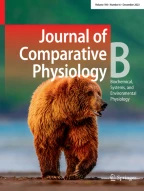Summary
Resting metabolic rates (RMR) of 34 species from 18 genera of boas and pythons (Serpentes: Boidae), with body masses ranging from 2 to 67,800 g, were determined as oxygen consumption (\(\dot V_{O_2 }\)) and carbon dioxide production (\(\dot V_{CO_2 }\)) at three ambient temperatures (T a).
The temperature coefficient of metabolism (Q10) averaged 2.61 betweenT a of 20–30°C and 2.65 between 30 and 34°C. The respiratory exchange ratio RE (=\(\dot V_{CO_2 }\)/\(\dot V_{O_2 }\)) increased slightly with increasingT a (0.795 at 20°C, 0.819 at 30°C, and 0.834 at 34°C). Interspecific differences in Q10 and RE were slight or insignificant.
A multiple regression relating metabolism (\(\dot V_{O_2 }\)) to mass andT a explained 97% of the variance in the pooled interspecific data. The mass exponent was 0.806, which is approximately the same as reported for squamates and for all reptilian taxa combined. The mean within-species slope (0.732) was significantly less than the slope for pooled data, but did not differ significantly from 0.75. In 40 of 42 cases (14 species at 3T a), within-species slopes did not differ from each other. Values of the adjusted mean Y, from covariance analysis, were significantly and positively correlated with mass, indicating that the mass coefficient increases with increasing mass.
Considerable variation in metabolic rate is apparent both within and between ecological and taxonomic categories.
Similar content being viewed by others
References
Andrews RM, Pough FH (1985) Metabolism of squamate reptiles: allometric and ecological relationships. Physiol Zool 58:214–231
Bennett AF, Dawson WR (1976) Metabolism. In: Gans C, Dawson WR (eds) Biology of the reptilia, vol 5. Physiology, Academic Press, New York, pp 127–233
Dmi'el R (1972) Relation of metabolism to body weight in snakes. Copeia 1972:179–181
Dmi'el R (1986) Intra- and interspecific allometry of oxygen consumption in snakes. J Herpetol 20:265–267
Feldman HA, McMahon TA (1983) The 3/4 mass exponent for energy metabolism is not a statistical artifact. Respir Physiol 52:149–163
Harlow P, Grigg G (1984) Shivering thermogenesis in a brooding diamond phython,Python spilotes spilotes. Copeia 1984:959–956
Hayssen V, Lacy RC (1984) A reexamination of mammalian metabolic rates. Am Zool 24:957
Hemmingsen AM (1960) Energy metabolism as related to body size an respiratory surfaces and its evolution. Rep Steno Mem Hosp (Copenh) 4:7–58
Heusner AA (1982) Energy metabolism and body size. I. Is the 0.75 mass exponent of Kleiber's equation a statistical artifact? Respir Physiol 48:1–12
Heusner AA (1984) Biological similitude: statistical and functional relationships in comparative physiology. Am J Physiol 246:R839–R845
Hinds DS, MacMillen RE (1984) Energy scaling in marsupials and eutherians. Science 225:335–337
Kleiber M (1961) The fire of life: an introduction to animal energetics. Wiley, New York
McMahon TA (1973) Size and shape in biology. Science 179:1201–1204
Nagy KA (1982) Energy requirements of free-living iguanid lizards. In: Burghardt GM, Rand AS (eds) Iguanas of the world. Noyes, Park Ridge, New Jersey, pp 49–59
Sokal RR, Rohlf FJ (1981) Biometry, 2nd edn. W.H. Freeman, San Francisco
Stinner JN (1982) Ventilation, gas exchange, and blood gases in the snake,Pituophis melanoleucus. Respir Physiol 47:279–298
Van Mierop LHS, Barnard SM (1978) Further observations on thermoregulation in the brooding femalePython molurus bivittatus (Serpentes: Boidae). Copeia 1978:615–621
Vinegar A, Hutchison VH, Dowling HG (1970) Metabolism, energetics, and thermoregulation during brooding of snakes of the genusPython (Reptilia, Boidae). Zoologica 55:19–48
Author information
Authors and Affiliations
Additional information
Original metabolic data are available from the National Auxiliary Publications Services, c/o Microfiche Publication, P.O. Box 3153 Grand Central Station, New York, New York 10017, USA
Rights and permissions
About this article
Cite this article
Chappell, M.A., Ellis, T.M. Resting metabolic rates in boid snakes: allometric relationships and temperature effects. J Comp Physiol B 157, 227–235 (1987). https://doi.org/10.1007/BF00692367
Accepted:
Issue Date:
DOI: https://doi.org/10.1007/BF00692367
